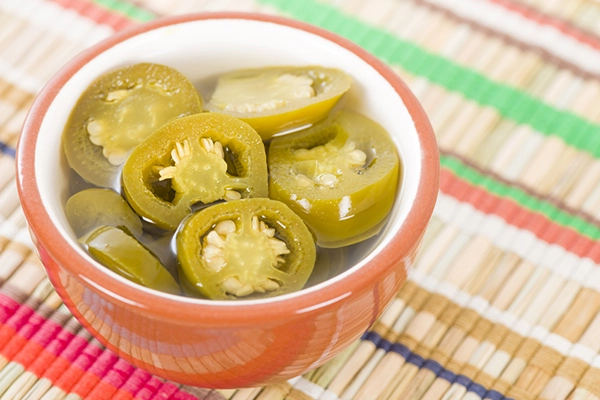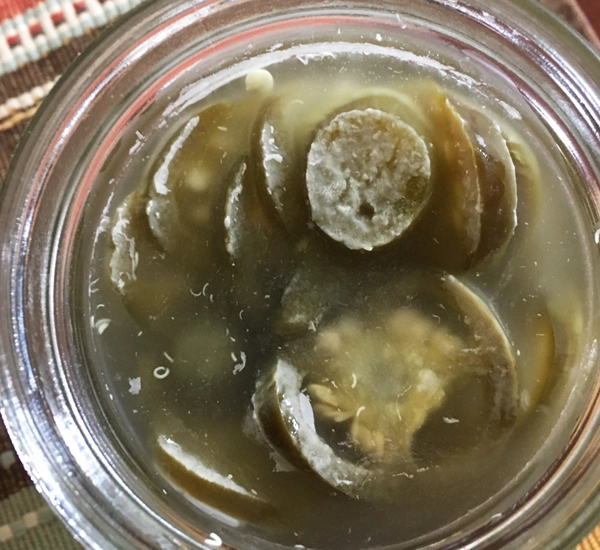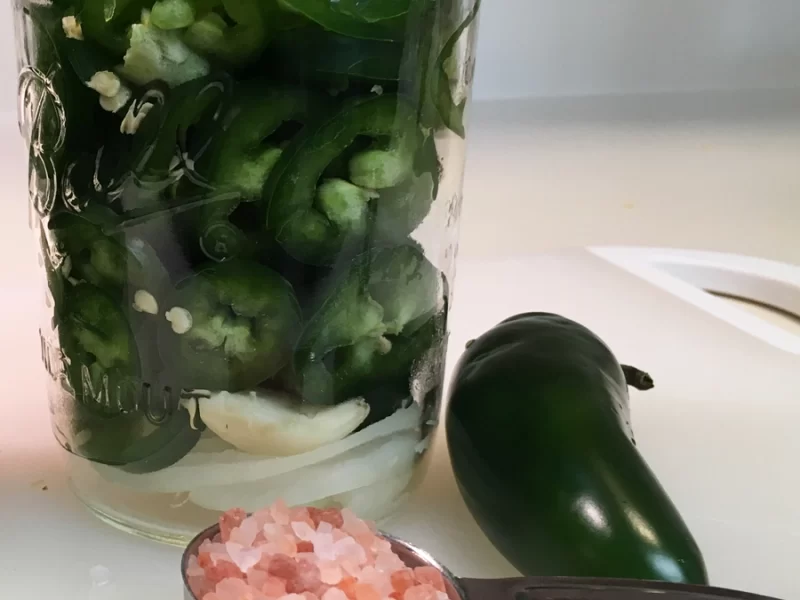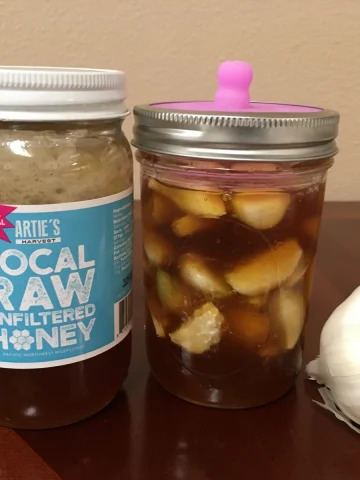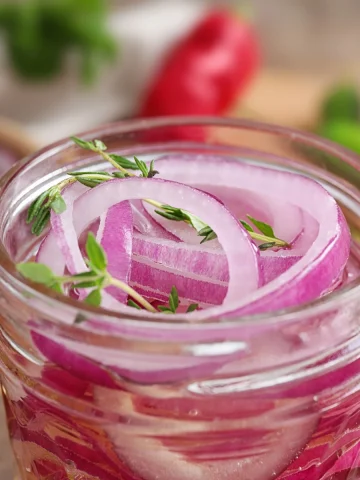How To Make Delicious and Easy Fermented Jalapeños
Fermented Jalapeños are my obsession! To make fermented jalapenos start by filling a jar with jalapenos and pouring in a saltwater brine. Then wait about one month to enjoy the perfect bite of crisp, spicy, and, quite honestly, the best topper to any dish!
Add a little onion, garlic, and coin-sliced carrots to make this tangy, spicy, fermented condiment pop even more.
Ways to Use Fermented Jalapeños
Once you start making fermented jalapeños, you won’t stop. They are so versatile you can put them on everything – hamburgers (topped with fermented ketchup), chili, scrambled eggs, nacho supreme, breakfast burritos, guacamole, you name it. Their tangy kick of spice makes them a great addition to any recipe.

Health Benefits of Fermented Jalapenos and other Vegetables
Probiotics = Good Bacteria
Fermented jalapenos contain probiotics, which are beneficial bacteria that act as the first line of defense against toxins and harmful bacteria.
Microorganisms that have a beneficial effect on our health are found in all Lacto-fermented foods.
Lactic acid bacteria in fermented vegetables may have several excellent benefits: cancer prevention, decreased cholesterol absorption, and reduced food allergies.
Fermented Vegetables Are Easier to Digest
Fermenting vegetables makes them much more digestible. Lacto-fermentation is an excellent ally of our digestive system.
Similar Recipes from Fermenters Kitchen: Fermented Curtido
Fermented Foods Contain Higher Levels of Nutrients
The process of fermentation increases the nutritional value of food, the bioavailability of nutrients, and the enzyme concentration and neutralizes several toxic substances.
Unlike canned vegetables, fermented vegetables keep all their nutrients and vitamins. Their nutritional value can even increase.
Furthermore, microorganisms generate various nutrients such as vitamin C, B group vitamins (including the famous B12), and vitamin K during fermentation. Bacteria also consume sugar from vegetables.
Capsaicin, which is responsible for the pepper’s heat, and Vitamin C are powerful antioxidants that help protect against heart disease. But that’s not all; these hot peppers provide our bodies with so much more: Jalapeños have high levels of Vitamin C, which help prevent healthy cells from mutating into cancerous cells.
Fermentation Process Reinforces Our Microbiota
Lacto-fermented foods are an essential source of probiotics and prebiotics. They help support and strengthen our digestion and health when we eat them regularly.
A large part of our digestion depends on microbiota, the second brain.
The microbiota gathers all the bacteria, yeast, and other microorganisms that live on and in our bodies. Which can be more than one hundred thousand billion microorganisms divided into more than 3,000 species.
These microorganisms live in symbiosis with our body and play a role in the body’s defense system, regulating blood pressure and the digestion of food.
Make this next: Lacto-fermented Salsa
How to Cut Jalapenos for a Fermented Jalapeno Recipe
Wear gloves when cutting jalapeños, and don’t touch your face and especially your eyes while handling them.
The heat in jalapenos is found in the seeds and inner membranes. If you want to reduce the heat in this recipe, you can easily remove the seeds and membranes by slicing the jalapeños in half lengthwise, then using a small spoon to scoop out the seeds and membranes.
When I cut the jalapeno peppers for this fermented recipe, I cut them horizontally into rounds and left them in the membranes and seeds.
Tools you may need:
- Wide-Mouth Mason Jars
- Glass Weights
- Airlock Fermenter Lids
- Pot
- Measuring Spoon
- Cutting board
- Knife
Tips for Fermenting Jalapeno Peppers:
- One of the most important things you need to do when fermenting is to keep everything submerged in the brine, so bad bacteria can't grow.
- Use weights or cabbage leaves to hold the peppers down.
- Allow the brine to cool completely before pouring over the jalapeños because hot water could kill any good bacteria.
- Save the leftover brine as a starter culture to help get the good bacteria growing on your next vegetable fermentation recipe. Simply add a few tablespoons at the start of any vegetable ferment recipe.
Salt brine For Fermented Jalapenos
Dissolve 1-3 tablespoons of salt in 1 quart of water to make the salt brine. Try experimenting with the amount of salt you use by reducing or increasing the amount of salt to fit your preferred taste.
Just be aware that if you use too little an amount of salt, mold and harmful bacteria can grow. And too much salt can slow the fermentation and even stop it altogether.
Another factor to consider is the fineness and coarseness of the salt. Each will fill a tablespoon differently, resulting in a different level of saltiness in the finished product.
Related: Best Peppers For Fermented Hot Sauce, How To Keep Fermented Hot Sauce From Separating
White Film on Fermented Peppers
It is common to find a white layer forming on the liquid of a fermented vegetable recipe only after a few days. Many people mistake this white film for mold.
However, the white film is usually a type of yeast known as Kahm yeast.
The good news is that Kahm yeast is not harmful. Even though it may be unattractive or smell odd, you don't have to throughout the whole batch of peppers.
You can remove the Kahm yeast from the ferment with a spoon, so it does not impart a foul odor. A little bit left in the jar is not harmful to the recipe or you.
Lacto-Fermented Jalapeño Recipe
Notes
- One of the most important things you need to do when fermenting is to keep everything submerged below the brine, so bad bacteria can't grow.
- Use weights or cabbage leaves to hold the peppers down.
- Allow brine to completely cool before pouring over the jalapeños because hot water could potentially kill any of the good bacteria.
- Save the leftover brine as a starter culture o help get the good bacteria growing on your next vegetable fermentation recipe. Simply add a few tablespoons at the start of any vegetable ferment recipe.
Ingredients
- 10-12 jalapeño peppers sliced or enough to fill two 16oz mason jars
- 2 Tablespoons fine sea salt (Himalayan pink sea salt (Amazon link)
- 1 Quart of filtered water, chlorine-free
- ½ of one medium-size onion, sliced
- 4-5 garlic cloves, peeled
- Additional options include mustard seeds, bay leaves, fresh herbs of choice, coin sliced carrots, cauliflower, or radishes.
Instructions
- In a saucepan, heat water. Add salt and stir till dissolved. Cool the salt brine to room temperature.
- Place the sliced jalapeños, onion, and garlic in clean wide-mouth jars. Top with the saltwater brine. Make sure to leave about an inch of headspace between the ferments and lid space.
- To keep the ingredients below the water, place a glass fermentation weight on top or use a few folded-up cabbage leaves to push the jalapeños below the brine. You can even use two carrot sticks, just crisscross them.
- Cover with a lid or use an airlock lid.
- If using a lid, be sure to "burp" your jar every day for the first week.
- Let the jalapeños sit at room temperature away from direct sunlight for at least 3-5 days.
- Give it a taste test to see if it has achieved the desired flavor. If not, reseal and continue for another few days. I like to wait at least one month.
- Once you are happy with the flavor of the jalapeño peppers, put a tight lid on the jar and move it to the refrigerator.

